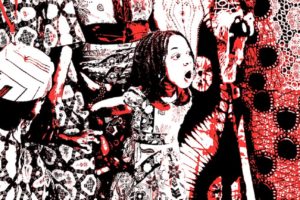 Giorgio Agamben is an Italian philosopher. Yes, philosophers do still exist. They are not all dead. And believe it or not they manage to say cool things from time to time. To be honest, like all philosophers, Agamben has written a good number of strange and hard-to-understand books. Reading some of his stuff would make your head hurt, and your eyes itch, and your stomach growl with sudden realization of hunger. But the piece below is different. Agamben is writing about a haunted city. He is struck by the fact that Venice is sort of like a cadaver. What do you do with a city that bears within itself the decayed remnants from distant pasts in the form of ruins? How can you make sense of living side by side with dead things, dead people, and dead memories? It’s a lovely piece. The writing is pretty. The bummer, however, is that you will only see the prettiness of the essay if you stick with it, if you read past the first clunky paragraph, and look past the silly big words, and do not freak out if you don’t know what the word flaneur means, and are not ticked off by the foreign words you can’t pronounce, and do not turn up your nose at terms like postmodernity. Again, its a reflection on ghosts not a treatise on the Nicomachean ethics.
Giorgio Agamben is an Italian philosopher. Yes, philosophers do still exist. They are not all dead. And believe it or not they manage to say cool things from time to time. To be honest, like all philosophers, Agamben has written a good number of strange and hard-to-understand books. Reading some of his stuff would make your head hurt, and your eyes itch, and your stomach growl with sudden realization of hunger. But the piece below is different. Agamben is writing about a haunted city. He is struck by the fact that Venice is sort of like a cadaver. What do you do with a city that bears within itself the decayed remnants from distant pasts in the form of ruins? How can you make sense of living side by side with dead things, dead people, and dead memories? It’s a lovely piece. The writing is pretty. The bummer, however, is that you will only see the prettiness of the essay if you stick with it, if you read past the first clunky paragraph, and look past the silly big words, and do not freak out if you don’t know what the word flaneur means, and are not ticked off by the foreign words you can’t pronounce, and do not turn up your nose at terms like postmodernity. Again, its a reflection on ghosts not a treatise on the Nicomachean ethics.
Just so you know, the piece is a chapter from a book titled Nudities. Originally written in Italian, it was translated in English last year. So it’s still quite fresh off the press. And Brittle Paper is giving you a part of the book that is not widely available online. Enjoy. Oh, for those who care, the title is a Nietzsche ripoff.
On The Uses and Disadvantages of Living Among Specters
By Giorgio Agamben
In the inaugural address at the University Institute of Architecture in Venice, delivered in February 1993, Manfredo Tafuri evoked the “cadaver” of Venice in no uncertain terms. Recalling the battle waged against those who proposed to host the World’s Fair in the city, he concluded, not without a note of sadness: “The problem was not whether it was better to put makeup and lipstick on the cadaver, thus making it look so ridiculous that even children would have mocked it; nor was it what we—the powerless defenders, the disarmed prophets—ended up with, that is, a cadaver liquefying before our very eyes.”
Almost two decades have passed since this implacable diagnosis, penned by a person with ample authority and competence, whose accuracy no one could possibly challenge in good faith (not even the mayors, architects, ministers, and the rest who, then as today, had and have, in Tafuri’s words, the «indecency” to continue to doll up and undersell the cadaver). To the careful observer this actually means, however, that Venice is no longer a cadaver, that if it somehow still exists, it is only because it has managed to move beyond the state that follows death and the consequent decomposition of the corpse. This new state is that of the specter, of the dead who appears without warning, preferably in the middle of the night, creaking and sending signals, sometimes even speaking, though in a way that is not always intelligible. “Venice is whispering,” Tafuri writes, though he adds that such whispers are an unbearable sound to the modern ear.
Those who live in Venice attain a certain familiarity with this specter. It suddenly appears during a nocturnal stroll when, crossing a bridge, one’s gaze turns a corner alongside a canal immersed in shadows, as a glimmer of orange light is switched on in a distant window, and an observing passerby on another bridge holds out a fogged-up mirror. Or when the Giudecca Island almost seems to gurgle as it drains rotten algae and plastic bottles onto the Zattere promenade. And it was yet again the same specter that—thanks to the invisible echo of a final ray of light, indefinitely lingering over the canals—Marcel saw enshrouded within the reflections of the palazzos in their ever-darkening obscurity. And prior still, this specter appears at the very origins of this city, which was not born, like almost every other city in Italy, as a result of the encounter between late antiquity in its decline and new barbarian forces but rather as a result of exhausted refugees who, abandoning their riches behind them in Rome, carried its phantasm in their minds, to then dissolve it into the city’s waters, streaks, and colors.
What is a specter made of? Of signs, or more precisely of signatures, that is to say, those signs, ciphers, or monograms that are etched onto things by time. A specter always carries with it a date wherever it goes; it is, in other words, an intimately historical entity. This is why old cities are the quintessential place of signatures, which the flaneur in turn reads, somewhat absentmindedly, in the course of his drifting and strolling down the streets. This is why the tasteless restorations that sugarcoat and homogenize European cities also erase their signatures; they render them illegible. And this is why cities—and especially Venice—tend to look like dreams. In dreams the eyes of the dreaming person seize on each and every thing; each and every creature exhibits a signature that signifies more than its traits, gestures, and words could ever express. Nonetheless, those who stubbornly try to interpret their dreams are still at least partly convinced that they are meaningless. Similarly, in the city, everything that has happened in some lane, in some piazza, in some street, on some sidewalk along a canal, in some back alley is suddenly condensed and crystallized into a figure that is at once labile and exigent, mute and winking, resentful and distant. Such figure is the specter or genius of the place.
What do we owe to the dead? “The work of love in recollecting the one who is dead,” Kierkegaard writes, “is the work of the most disinterested, free, and faithful love.” But it is certainly not the easiest. The dead, after all, not only ask nothing from us, but they also seem to do everything possible in order to be forgotten. This, however, is precisely why the dead are perhaps the most demanding objects of love. We are defenseless and delinquent with respect to the dead; we flee from and neglect them.
Only in this way can one explain the Venetians’ lack of love for their city. They do not know how to love it, nor are they capable of loving it, since loving the dead is difficult. It is much easier to pretend that it is alive, to cover its delicate and bloodless members with some makeup and rouge in order to exhibit it to the tourists who pay an admission price. In Venice the merchants are to be found not in the temple but in the tombs, where they offend not only the living but even more so the cadaver (or rather what they believe to be a cadaver, though without being able to confess it). But this cadaver is actually a specter, that is to say (if the merchants are aware of its existence), the most nebulous and subtle entity, and thus as distant from a cadaver as one can imagine.
Spectrality is a form of life, a posthumous or complementary life that begins only when everything is finished. Spectrality thus has, with respect to life, the incomparable grace and astuteness of that which is completed, the courtesy and precision of those who no longer have anything ahead of them. It is creatures of this kind that Henry James learned to perceive in Venice (in his ghost stories he compares them to sylphs and elves). These specters are so discrete and so elusive) that it is always the living who invade their homes and strain their reticence.
But there is also another type of spectrality that we may call larval, which is born from not accepting its own condition, forgetting it so as to pretend at all costs that it still has weight and flesh. Such larval specters do not live alone but obstinately look for people who generated them through their conscience. They live in them as nightmares, as incubi or succubi, internally moving their lifeless members with strings made. While the first type of spectrality is perfect, since it no longer has anything to add to what it has said or done, the larval specters must pretend to have a future in order to clear a space for some torment from their own past, for their own incapacity to comprehend that they have, indeed, reached completion.
Ingeborg Bachmann once compared language to a city, with its ancient center, its more recent and peripheral boroughs, and finally the encircling beltway and its gas stations, which are also an integral part of the city. The same utopia and the same ruin are contained in our city and in our language, and we have dreamt and lost ourselves in both; indeed, they are merely the form that this dream and this loss take. If we compare Venice to a language, then living in Venice is like studying Latin, like trying to pronounce every word, syllable by syllable, in a dead language; learning how to lose and rediscover our way in the bottlenecks of declensions and unexpected openings of supines and future infinitives. It must be remembered, though, that one should never declare a language dead provided that it still somehow speaks and is read; it is only impossible—or nearly impossible—to assume the position of a subject in such a language, of the one who says “I.” The truth is that a dead language, just like Venice, is a spectral language that we cannot speak but that still quivers and hums and whispers in its own special way, so we can eventually come to understand and decipher it, albeit with some effort and the help of a dictionary. But to whom does a dead language speak? To whom does the specter of language turn? Not to us, certainly, but not even to its addressees from another time, of whom it no longer has any recollection. And yet, precisely for this reason, it is as if only now for the first time, that this language speaks, a language the philosopher refers to (though without realizing that he has thus bestowed it with a spectral consistency) by saying that it speaks—not we.
Venice is therefore the true emblem of modernity, even if in a completely different sense from the one evoked by Tafuri at the end of his inaugural address. Our time is not new [nuovo] but last [novissimo], that is to say, final and larval. This is what we usually understand as posthistory or postmodernity, without suspecting that this condition necessarily means being consigned to a posthumous and spectral life, without imagining that the life of the specter is the most liturgical and impervious condition, that it imposes the observance of uncompromising rules of conduct and ferocious litanies, with all their special prayers for dawn, dusk, night, and the rest of the canonical hours.
Hence the lack of rigor and decency of the larval specters who live among us. All peoples and all languages, all orders and all institutions, all parliaments and all sovereigns, the churches and the synagogues, the ermines and the gowns, have slipped one after another, inexorably, into a larval condition, though they are unprepared for and unconscious of it. And so writers write badly, since they need to pretend that their language is alive; parliaments legislate in vain because they need to simulate a political life for their larval nations; religions are deprived of piety because they no longer know how to bless the tombs and feel at home among them. This is the reason why we see skeletons and mannequins marching stiffly and mummies pretending to cheerfully conduct their own exhumation, without realizing that their decomposed members are leaving them in shambles and tatters, that their words have become glossolalic and unintelligible.
But the specter of Venice knows nothing of any of this. It no longer appears to the Venetians or, of course, to the tourists. Perhaps it appears to beggars who are chased away by brazen administrators, or to rats who anxiously cross from lane to lane with their muzzles to the ground, or to those rare people who, like exiles, to lucubrate on this often avoided lesson. Since what the specter argues, with its choirboy-like voice, is that if all the cities and the languages of Europe now survive only as phantasms, then only those who have understood these most intimate and most familiar deeds, only those who recite and record the discarnate words and stones, will perhaps be able one day to reopen that breach in which history—in which life—suddenly fulfills its promise.
Photo Credit: Andreas Templin








COMMENTS -
Reader Interactions